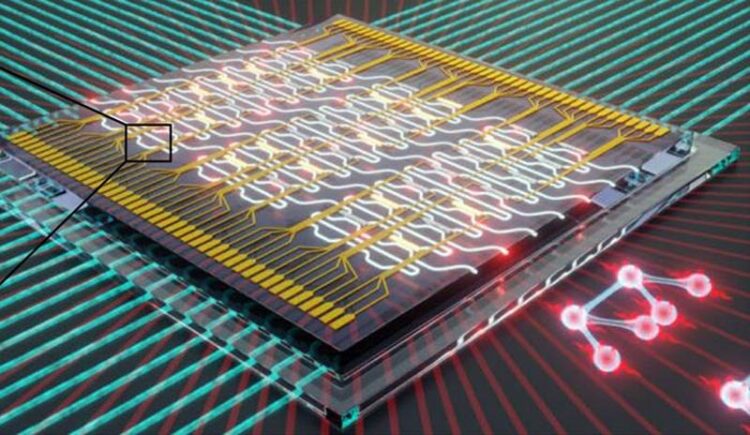Promising building blocks for photonic quantum simulators

A programmable chip is used to process the quantum information transmitted by single photons. Each pink dot represents a single photon, and the links between them represent quantum entanglement – which is the way quantum information is shared between different photons.
Credit: Stefano Paesani
Researchers at the Niels Bohr Institute have, collaborating with the University of Münster and Ruhr-Universität Bochum, developed new technology capable of processing the enormous amounts of information quantum systems generate. Deterministic single photon light sources, creating quantum bits at extreme rates and speed are now coupled to specially designed, integrated photonic circuits, capable of processing quantum information with adequate speed and quality without degrading the susceptible quantum states. This means that the first steps have been taken towards the development of photonic quantum devices that can, for example, describe and simulate other complex quantum systems – like the vibrational dynamics of biological molecules. The result is published in Science Advances.
The long haul now shows its value
Professor Peter Lodahl and the research group Quantum Photonics at the Niels Bohr Institute, University of Copenhagen have worked in this field for nearly twenty years. In short, it is all about the use of single photons, the smallest parts of light, used to code quantum information.
This is a rapidly developing field, demonstrating a single-photon encrypted communication link in the autumn of 2022 and a recent record investment in the spin-out business Sparrow Quantum.
At the core of it all are the photon sources developed and refined by the group over many years. Presently with unparalleled control, precision and quality, opening the doors to new research and development in quantum technology.
Quantum simulator – what’s all that about?
As soon as the word “quantum” is on the table it is often followed by the word “computer” – the idea of an extremely strong platform for calculations, with the capacity of dealing with complex problems.
Peter Lodahl says that the work done in connection with this result points in the direction of what they call a “quantum simulator”.
A quantum simulator is a special-purpose computer that simulates quantum systems by processing quantum information (quantum bits) that classical computers have a hard time dealing with.
“The processing of quantum information demands an exponentially increasing capacity on a classical computer when increasing the number of quantum bits. This means that even rather simple quantum mechanical problems cannot be solved on classical computers”, says Stefano Paesani, one of the leading researchers behind the result.
What is the purpose of a quantum simulator?
What does “processing” quantum information mean? This is where a crucial interdisciplinary element comes in.
Within the framework of the Novo Nordisk Foundation Project, “Solid-State Quantum Simulators for Biochemistry (SolidQ)”, photons, interacting in a photonic circuit, can be used to describe the characteristics of biochemical processes.
You can use one system (photons) to learn about the other system (the biomolecule) because the photonic quantum simulator can process the complex quantum information that describes it. One of the challenges consists in understanding the connection between the two complex quantum systems.
A quantum simulator relies on the congruence between different quantum systems
“We can learn about one system by studying the other – i.e. you can “map” one system to another. The initial insight into a complex system is crucial, however.
For example, there is a natural mapping occurring between photons and the vibration dynamics of molecules: When a molecule vibrates its evolution is described by the same quantum mechanical operation that describes photons sent through a circuit.”, says Peter Lodahl.
Technologies must “shake hands”
The challenge is to process the photons blasting away at the speed of light and in high numbers. It must happen extremely quickly and without loss. Not too many errors are allowed to happen.
Collaborating with the University of Münster the groups have, over the last two years, developed photonic circuits capable of processing quantum bits from the photonic source – and have made the two systems fit together. The Novo Nordisk Foundation project SolidQ has been all about optimizing the processing of photons.
“The collaboration with Münster is a great example of the fact that the research community takes the first steps. Subsequently, we make a “road map” for up-scaling the technology.
This platform looks very promising indeed and in working with Münster we succeeded in realizing photonic circuits adequately efficient and fast to keep up with our photon sources. We’re opening the door to applications now”, says Stefano Paesani.
Journal: Science Advances
DOI: 10.1126/sciadv.adg7268
Method of Research: Observational study
Subject of Research: Not applicable
Article Title: High-speed thin-film lithium niobate quantum processor driven by a solid-state quantum emitter
Article Publication Date: 12-May-2023
All latest news from the category: Information Technology
Here you can find a summary of innovations in the fields of information and data processing and up-to-date developments on IT equipment and hardware.
This area covers topics such as IT services, IT architectures, IT management and telecommunications.
Newest articles

First-of-its-kind study uses remote sensing to monitor plastic debris in rivers and lakes
Remote sensing creates a cost-effective solution to monitoring plastic pollution. A first-of-its-kind study from researchers at the University of Minnesota Twin Cities shows how remote sensing can help monitor and…

Laser-based artificial neuron mimics nerve cell functions at lightning speed
With a processing speed a billion times faster than nature, chip-based laser neuron could help advance AI tasks such as pattern recognition and sequence prediction. Researchers have developed a laser-based…

Optimising the processing of plastic waste
Just one look in the yellow bin reveals a colourful jumble of different types of plastic. However, the purer and more uniform plastic waste is, the easier it is to…



